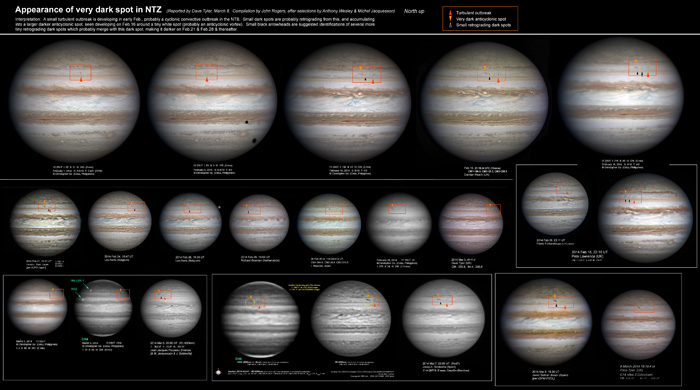|
March 9, 2014
|
|
Japanese (translated by Yuichi Iga)
Hi all, That’s indeed a notable and interesting dark spot: thanks to Dave Tyler for spotting it, and to Anthony and Michel for assembling those sets of images, and to everyone else who has observed it. Anthony and Michel have shown that it is a meteorological feature which developed over several weeks, although it was certainly worth investigating a possible impact origin for such a notable dark spot. From it's latitude of 32 deg.N, it's an anticyclonic dark spot. Attached is a more extensive set of images, with the feature(s) of interest marked. In deference to the people who provided the great majority of these images, and to professional interest in this, north is up in this set! But I can send a version with south up, or a version without labels, if required. This seems to be another example where small-scale but intense turbulence in the cyclonic belt gives rise to retrograding disturbance which feeds dark material into the adjacent anticyclonic zone. This is happening at other longitudes in the N. Temperate domain at present, in the aftermath of the 2012 NTB revival, as small cyclonic rifted regions produce dark material which comprises a ‘North Temperate Disturbance’ in the NTZ [refs. 1 & 2]. It also sometimes happens in the S. Temperate domain, in the ‘Sf. tail’ of a dark STB segment, generating an anticyclonic dark spot [ref.3]. In the present case, the best images show a small turbulent outbreak developing in the NTB in early Feb., then the very dark spot developing f. it, initially on Feb.16 when you can see tiny dark spots enveloping a tiny white spot, which I suggest was an anticyclonic vortex. The small black arrowheads are suggested identifications of subsequent tiny dark spots which I think were arising from the turbulent outbreak (so small-scale that it is barely visible in some images) and retrograding to merge with the very dark spot, making it especially dark on Feb.21 and Feb.28 and thereafter. best regards, John
|
|
 Click for the original size
|
|
References to our recent bulletins:
[1] 2013/14 Report no.4
[2] Set of images sent out last month, showing the bright new outbreak in NTB
[3] ‘Jupiter’s South Temperate domain: Behaviour of long-lived features and jets, 2001-2012’
|
|
_______________________________ John H. Rogers, Ph.D. Jupiter Section Director, British Astronomical Association jhr11@cam.ac.uk http://www.britastro.org/jupiter/ _________________________________
|
|
New dark spot in NTZ
2014年 3月 9日
|
|
 Click for the original size
|
|
我々の最近の会報への参照
[1] 2013/14 Report no.4
[2] Set of images sent out last month, showing the bright new outbreak in NTB
[3] ‘Jupiter’s South Temperate domain: Behaviour of long-lived features and jets, 2001-2012’
|
|
_______________________________ John H. Rogers, Ph.D. Jupiter Section Director, British Astronomical Association jhr11@cam.ac.uk http://www.britastro.org/jupiter/ _________________________________
|
|
【日本語訳:伊賀祐一 (Yuichi Iga)】 |